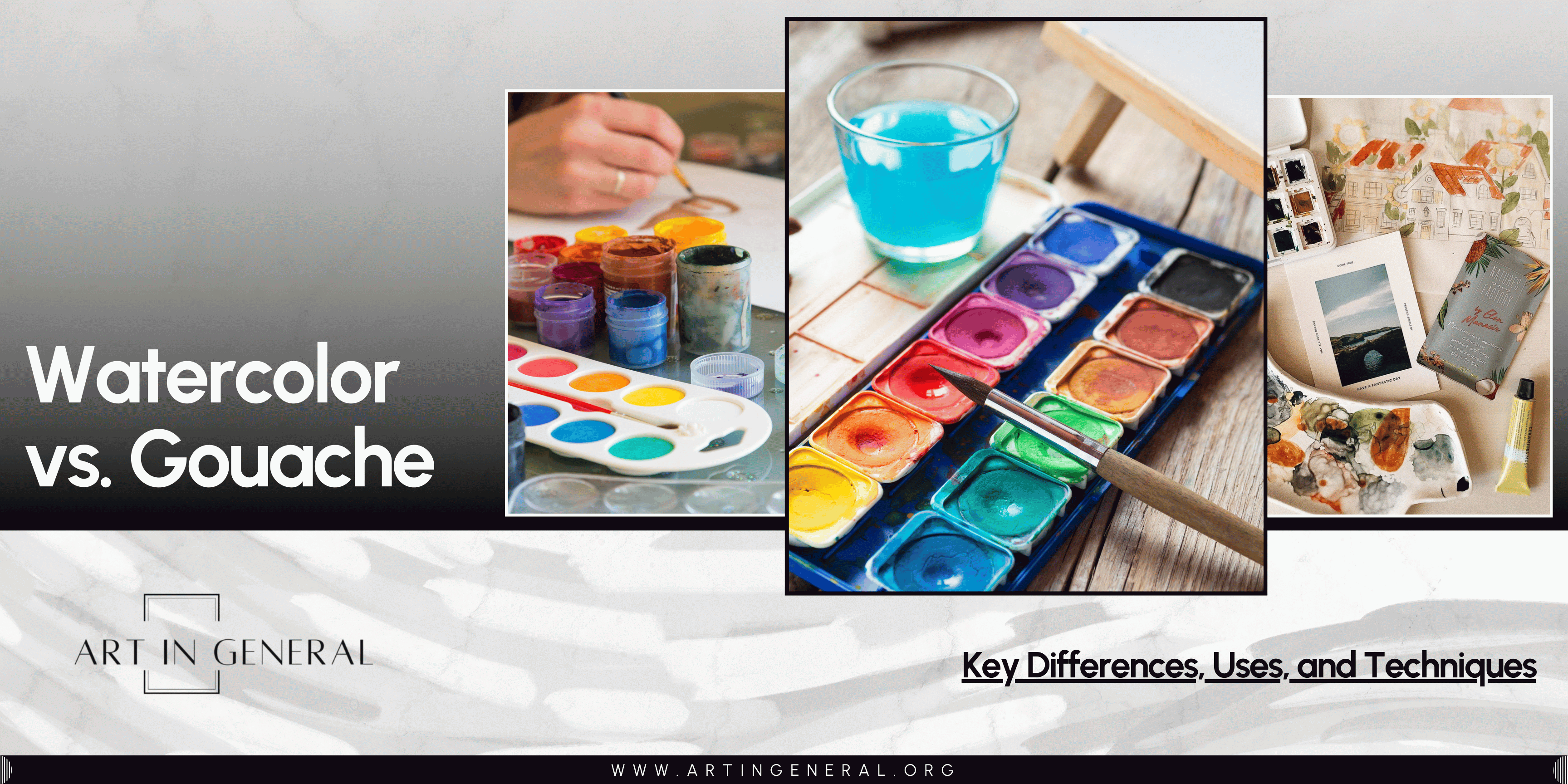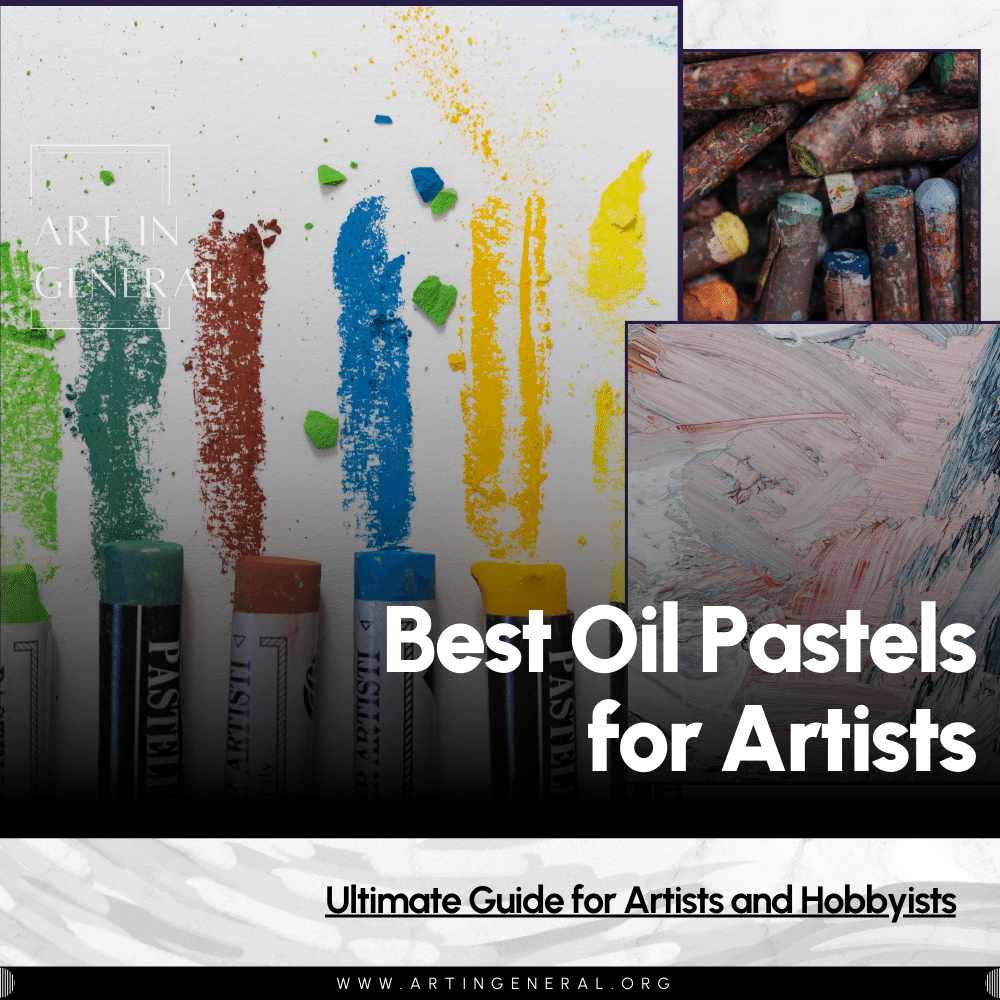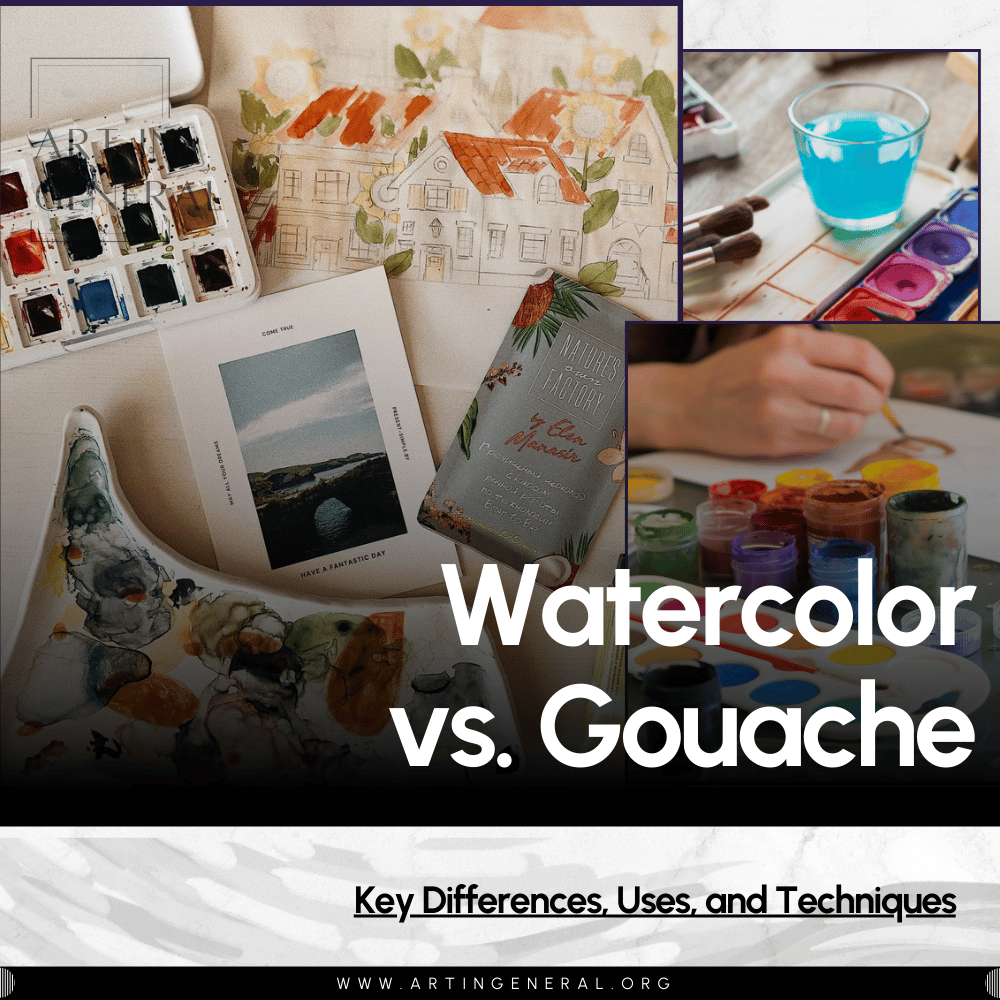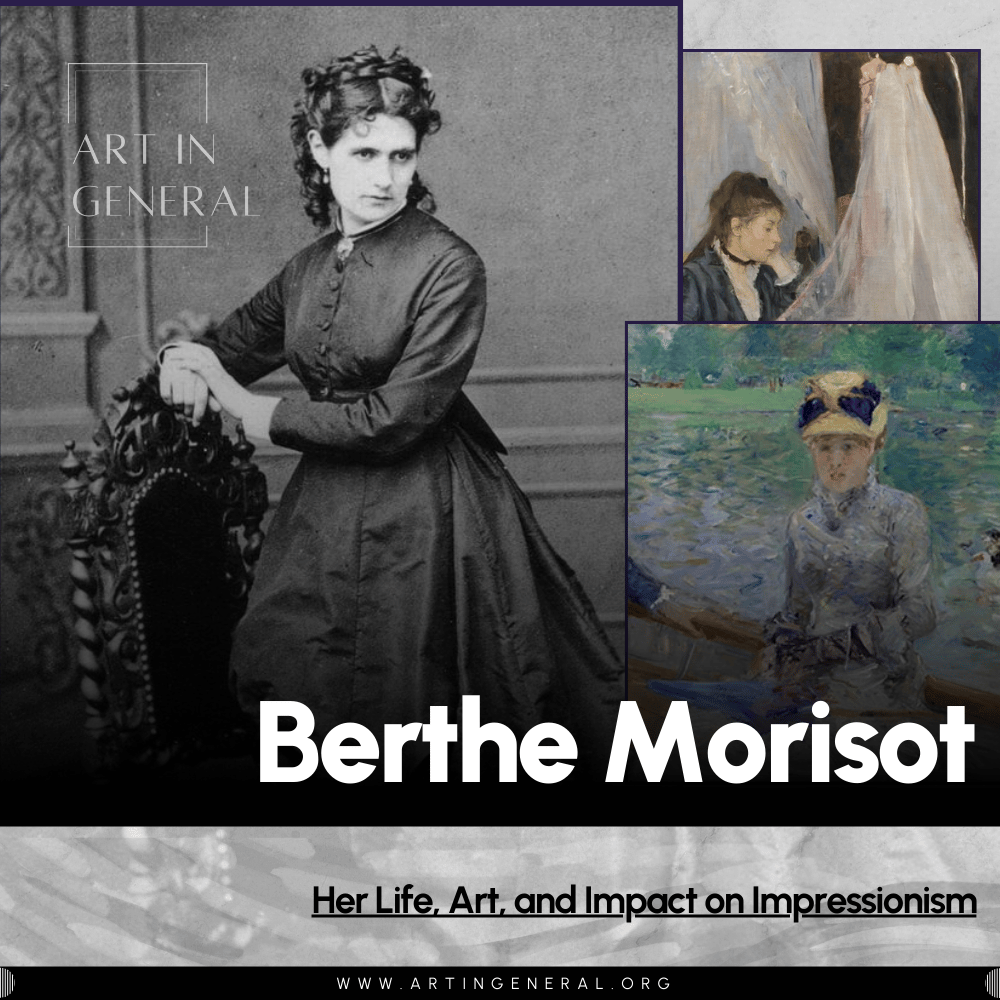 Watercolor and Gouache are two mediums beloved by many artists, each with unique qualities that can transform any sketch and idea into a beautiful painting. If you’re deciding between watercolor and gouache, here’s what you need to know: both are water-based paints, but they each bring something different to the table. Watercolor’s transparency lets you create light, layered effects, while gouache gives you vibrant, opaque color that’s easy to layer over. This guide will break down the main differences, what makes each medium unique, and help you pick the one that fits your style best. Whether you’re just starting out or adding to your toolkit, understanding these two will set you up for success. Let’s get started!
Watercolor and Gouache are two mediums beloved by many artists, each with unique qualities that can transform any sketch and idea into a beautiful painting. If you’re deciding between watercolor and gouache, here’s what you need to know: both are water-based paints, but they each bring something different to the table. Watercolor’s transparency lets you create light, layered effects, while gouache gives you vibrant, opaque color that’s easy to layer over. This guide will break down the main differences, what makes each medium unique, and help you pick the one that fits your style best. Whether you’re just starting out or adding to your toolkit, understanding these two will set you up for success. Let’s get started!
What is Watercolor Paint?
 Watercolor Paint is an art medium with amazing translucent capabilities made of finely ground pigment mixed with a water-soluble binder— usually gum arabic—that when mixed with water creates transparent washes of color that can be layered to achieve beautiful effects. Watercolors unlike other mediums offer the artist the possibility to play with the paper’s inherent luminosity, since they are not opaque the white must be preserved instead of added in the end, making it the perfect medium to capture light. Artists often use watercolors for painting landscapes, and portraits, and is a popular medium for illustrations as you can layer the colors to increase their intensity, make broad washes and gradients, but also work in small details with them, and they are also easy to use and relatively mess-free.
Watercolor Paint is an art medium with amazing translucent capabilities made of finely ground pigment mixed with a water-soluble binder— usually gum arabic—that when mixed with water creates transparent washes of color that can be layered to achieve beautiful effects. Watercolors unlike other mediums offer the artist the possibility to play with the paper’s inherent luminosity, since they are not opaque the white must be preserved instead of added in the end, making it the perfect medium to capture light. Artists often use watercolors for painting landscapes, and portraits, and is a popular medium for illustrations as you can layer the colors to increase their intensity, make broad washes and gradients, but also work in small details with them, and they are also easy to use and relatively mess-free.
What Is Watercolor Paint Made Of?
 Watercolor Paint is made of pigment, a gum binder, and in some cases, additives and fillers.
Watercolor Paint is made of pigment, a gum binder, and in some cases, additives and fillers.
- Pigments: Pigments are finely ground powder that comes from several different natural and synthetic sources. They are what define the color of a paint tube or pan, and are usually what also define the lightfastness and durability of a paint.
- Binder: Gum arabic is the preferred and most used binder in the watercolor-making process due to its excellent solubility in water and high compatibility with most pigments.
- Additives: The most common additives used in the watercolor paint-making process are Glycerin, Ox Gall, and Honey which are commonly used to improve the paint’s flow, performance, and longevity. The most common fillers are Kaolin Clay, Silica, and Calcium Carbonate, which adjusts the opacity and texture of the paint and are usually found in low-quality watercolor paints.
Why Is Watercolor Popular Among Artists?
Watercolors are a beautiful medium to work with—the magic of mixing colors with water, building up tones and values, and the ease with which you can create stunning gradients make them truly special. Watercolors are a popular medium among artists because they are not only incredibly versatile but also one of the most intuitive and easy-to-use mediums. They are also very portable, plus artists don’t need a complex setup to start painting. Watercolors are very beginner-friendly and the subtle and vibrant colors they produce have captured the hearts of many artists all around the globe.
What is Gouache Paint?
 Gouache Paint is an opaque, water-based painting medium made of finely ground pigment powder mixed with a binder—usually gum arabic or tragachant gum— as well as opacifiers and other additives that give the paint that opaque and velvety finish we all know and love.
Gouache Paint is an opaque, water-based painting medium made of finely ground pigment powder mixed with a binder—usually gum arabic or tragachant gum— as well as opacifiers and other additives that give the paint that opaque and velvety finish we all know and love.
Gouache paint is water-based, which means is soluble in water and can also be re-activated with it, so artists must be careful when working on multiple layers. It also has a higher pigment load, which makes it more vibrant than watercolors, and since they are opaque, they are much more forgiving than watercolors and can be worked from dark to light.
Gouache is the preferred medium of artists, illustrators, and designers because it adds a graphic feeling to their work, plus since it dries fully mate, it is easy to photograph and reproduce, making it great for printed media and design work. Gouache paint can be tricky for beginners as in most cases, it changes color once it dries, becoming either lighter or darker depending on the shade, however, once one gets used to it is an excellent medium to learn and experiment with.
What Is Gouache Paint Made Of?
Gouache paint is made of pigment, binders, additives, and fillers.
- Pigments: Pigments are finely ground powder that comes from several different natural and synthetic sources. They are what define the color of a tube or a cup of gouache, and also define the paint’s longevity and lightfastness. Gouache has a higher pigment load, and to avoid using fillers, some brands use mostly opaque pigments, using fillers only when absolutely needed.
- Binder: Gum arabic and tragacanth gum are the preferred and most used binders in the gouache-making process due to their excellent solubility in water and high compatibility with most pigments. Honey and Acrylic Polymer emulsions are also used, improving the flow and stability of the paint as well as its durability.
- Additives: The most common additives sussed in the gouache paint-making process are chalk, calcium carbonate, and talc, which help improve the paint’s opacity. Additives like Xanthan Gum, CMC, and other thickeners are added to improve the paint’s consistency, texture, and stability.
What’s The Difference Between Watercolor And Gouache?
 Gouache paint is very similar yet also completely different from watercolors. While their formulations may be similar in some cases, they yield entirely different results and require different approaches.
Gouache paint is very similar yet also completely different from watercolors. While their formulations may be similar in some cases, they yield entirely different results and require different approaches.
For starters, gouache has a higher pigment load, often consisting of only pigment and gum arabic at a higher concentration, making the paint significantly more expensive than watercolors.
Gouache is very opaque; although it can be diluted for lighter washes, it dries differently than watercolors, lacking their translucency and brightness.
Gouache is designed to be used in thick layers and allows artists to work from dark to light. In contrast, watercolors require preserving light by painting around it and must be worked from light to dark.
Additionally, gouache is much more forgiving than watercolors. It can be easily lifted and covered with other shades, while a dark stain in watercolor is harder to lift and more permanent.
Watercolor vs. Gouache: The Key Differences
Transparency vs. Opacity
 Watercolor is a transparent medium, the inherent transparency of the paint allows light to pass through, making the white of the paper the lightest value of any painting. While it is possible to achieve deep and intense colors with watercolor paint, it requires a lot of color build-up and often multiple layers when using pan watercolors or using paint straight out from the tube when using tube watercolors. Gouache on the other side, is very opaque, it comes in a creamy consistency on any of its presentations and while it’s possible to achieve transparent layers with it, they are never as transparent and bright as when using watercolors.
Watercolor is a transparent medium, the inherent transparency of the paint allows light to pass through, making the white of the paper the lightest value of any painting. While it is possible to achieve deep and intense colors with watercolor paint, it requires a lot of color build-up and often multiple layers when using pan watercolors or using paint straight out from the tube when using tube watercolors. Gouache on the other side, is very opaque, it comes in a creamy consistency on any of its presentations and while it’s possible to achieve transparent layers with it, they are never as transparent and bright as when using watercolors.
Layering Techniques
 Watercolor painting relies heavily on layering techniques, both to mix and deepen colors. When painting with watercolors, highlights, and light values must be preserved by not painting over them, using masking techniques, or painting around them. Maintaining the transparency of watercolors is a key point of watercolor painting. Art made with it often has an ethereal, soft, delicate, and spontaneous nature, as colors blend and bleed with each other.
Watercolor painting relies heavily on layering techniques, both to mix and deepen colors. When painting with watercolors, highlights, and light values must be preserved by not painting over them, using masking techniques, or painting around them. Maintaining the transparency of watercolors is a key point of watercolor painting. Art made with it often has an ethereal, soft, delicate, and spontaneous nature, as colors blend and bleed with each other.
Gouache paint easily covers the layer beneath, requiring a more straightforward approach when painting with it. Due to its high opacity, artists can work from dark to light, and there is no need to preserve highlights, however a deep understanding of color mixing and color theory is required, especially with gouache paint that changes color when it dries.
 Additionally, gouache can be reactivated with water, enabling artists to lift and manipulate the paint more easily than with traditional watercolors, but making glazing and soft layering very difficult too.
Additionally, gouache can be reactivated with water, enabling artists to lift and manipulate the paint more easily than with traditional watercolors, but making glazing and soft layering very difficult too.
Finish and Texture
 Watercolor paint dries with a soft, luminous finish, sometimes even slightly glossy. Gouache on the other side, dries completely matte, with a soft velvety texture that doesn’t reflect light.}
Watercolor paint dries with a soft, luminous finish, sometimes even slightly glossy. Gouache on the other side, dries completely matte, with a soft velvety texture that doesn’t reflect light.}
The texture of watercolor can vary greatly depending on the paper used (hot press, cold press, or rough) and the technique applied, additionally, techniques like wet-on-wet can create soft blends and blooms, adding to the overall texture of the painting.
Unlike the smooth finishes typical of watercolor, gouache can retain visible brush strokes, this can lead to a dimensional quality in the painting, especially if using techniques like dry brushing or palette knife application.
Presentation and Price
Watercolor comes in three different presentations, pans, tubes, and inks. Pans are dried watercolors shaped into small squares that need to be reactivated with water. Tubes are fresh creamy watercolor paint packed in tubes, the paint can be used straight from the tube but still needs a significant amount of water to improve the flow. Inks are very saturated liquid watercolor paint that comes in small bottles, often used for areas that need fluidity and saturation.
Gouache paint comes in tubes and pods, the last being a recent presentation that is very popular among young artists. Gouache paint is meant to be used straight from the tube, and while water can be added for washes and to improve the flow of the paint, is not nearly as much as the amount used with watercolors.
Can You Use Watercolor and Gouache Together?
Yes, watercolor and gouache paint can and are often used together. Since they both are water soluble, have a similar color range, and give completely different—and often complementary— effects, watercolor and gouache are used together in illustration, design, and urban sketching.
Watercolors are often used as a base, for light washes and atmospheric effects in the background, while gouache is used for detail, highlights, and bold color accents.
Which Medium is Easier for Beginners?
While both mediums have their yays and nays, both are excellent mediums for beginners. Watercolor is a very fluid medium, and requires a lot of patience, but is perfect for developing foundational skills and learning about color theory, optical mixing, and layering. Gouache is an opaque and thick medium, perfect for learning color mixing, depth, and value, and is much more forgiving than watercolors.
However, the medium we choose as the best for absolute beginners is watercolor due to its accessibility, price, and wide color range which has yet to be matched by gouache and other mediums.
Gouache vs. Watercolor FAQs
Here are some of the most frequently asked questions about gouache and watercolor:
Can You Mix Watercolor And Gouache Together?
Yes, and in more than one aspect too. Since both mediums are water-based, and use pretty much the same pigments and similar binders, you can mix them together on a separate palette to create new colors and also use them for different effects in your art. We must mention that mixing watercolor into gouache results in new colors without affecting the gouache finish and texture a lot; you can’t get new colors by mixing gouache into watercolors without affecting the inherent translucent qualities of watercolor.
Is Gouache Easier To Use Than Watercolor?
Yes and No. Gouache paint is more forgiving and its application is more straightforward than watercolors, however, due to its opacity and color-changing nature, it’s not as easy as watercolors which allow for gradual color build and layering techniques that create smooth transitions. While gouache can provide vibrant results quickly, mastering its use requires an understanding of how it dries and how to manage its thickness effectively.
Is Gouache Or Watercolor Better For Illustration?
Both gouache and watercolor have their strengths in illustration. Gouache is often chosen for its opacity and ability to create bold colors, making it suitable for graphic styles. Watercolor, on the other hand, is excellent for soft washes and creates beautiful atmospheric effects. The choice depends on the artist’s style and preference.
Is Gouache Better Than Watercolor For Professionals?
Both are excellent mediums for professional artists and are often used together by many of them. Gouache is favored for its vibrant colors and solid coverage, while watercolor is appreciated for its transparency and fluidity, so it mostly depends on the artist’s preference and the type of project they’re working on.
Is Gouache Waterproof Once Dry?
No, Gouache can be easily activated with water once dry, which is both a blessing and a curse. This characteristic makes gouache very forgiving for mistakes, however it also makes it tricky for glazing and layering techniques. The only “gouache paint” that is waterproof once dry is acrylic gouache, which is simply an acrylic paint with improved flow and a matte finish.
Why Does Gouache Crack?
When gouache paint is applied too thickly it might crack as it dries, which can also happen if the paint dries unevenly. Additionally, if the paint is low quality, not mixed properly or if there is a high concentration of pigment, it can also lead to cracking.
Can I Use Gouache With Watercolor Brushes?
Yes, you can. But we don’t recommend it, especially when talking about specialty watercolor brushes, which are very delicate, very expensive, and can wear easily when used with other mediums. It’s best to use brushes that are specifically designed for gouache or acrylics, as these tend to have sturdier bristles that can handle the thick consistency of gouache paint.
What Paper Is Best for Gouache vs. Watercolor?
Gouache and watercolor are both water-based and water-soluble mediums, and both of them require special paper that can handle water application and several layers of paint. The main difference is that the amount of water used in watercolor painting is much higher than the amount of water used in gouache painting as watercolor often uses several washes and gets the paper completely wet over and over.
- For Watercolor, Ideally, use paper that is 300 gsm (140 lb) or heavier to withstand multiple washes and prevent warping.
- For Gouache, choose paper that is 200 gsm (90 lb) or heavier to support the thicker application of gouache. Cold press and hot press watercolor papers work well, as do heavier mixed media papers.
Watercolor paper is good for both watercolor and gouache, however, we recommend a paper that is on the heavier side for wet-on-wet techniques. Here are the different types of paper for watercolor and gouache and its uses:
-
- Cold Press (NOT): This paper has a textured surface, which is excellent for both gouache and watercolor painting. It’s ideal for traditional watercolor techniques, washes, and blending, and is better for beginners as it handles more water than hot pressed watercolor paper and it’s easier to control the paint’s flow than with rough watercolor paper.
- Rough: This heavily textured paper provides dramatic effects and is perfect for achieving strong textures and bold washes. It’s great for expressive, painterly styles, but not recommended for beginners or for painting with gouache as it leads to uneven application and possible cracking.
- Hot Press (Smooth): This smooth paper is great for detailed work, fine lines, and illustrations. It allows for more control and is suitable for techniques that require precision. Great for gouache painting, and recommended for advanced watercolor artists as it’s not as forgiving and doesn’t handle water as well as cold-pressed watercolor paper.
- Mixed Media Paper: Heavier mixed media paper (around 250 gsm or higher) can also be used for gouache and watercolor, as it can handle moisture and thicker applications, but it’s recommended to look for the one made for wet media specifically.





Leave a Reply